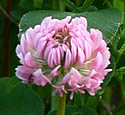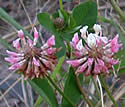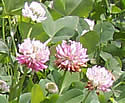Trifolium hybridum (Alsike Clover)
| Also known as: | |
|---|---|
| Genus: | Trifolium |
| Family: | Fabaceae (Pea) |
| Life cycle: | perennial |
| Origin: | Eurasia |
| Status: |
|
| Habitat: | part shade, sun; fields, roadsides, waste areas, disturbed soil |
| Bloom season: | June - September |
| Plant height: | 1 to 2 feet |
| Wetland Indicator Status: | GP: FACU MW: FACU NCNE: FACU |
| MN county distribution (click map to enlarge): |  |
| National distribution (click map to enlarge): |  |
Pick an image for a larger view. See the glossary for icon descriptions.
Detailed Information
Flower: 

![[photo of flower]](/udata/r9ndp23q/pd/trifolium-hybridum-6-t.jpg) A single round flower head on a 1 to 3 inch stalk arising from a leaf axil. Heads are about ¾ inch diameter, densely packed with tiny pea-shaped flowers. Flowers have a sharply pointed upward curved petal (standard) with small lateral wings below it and a keel in the throat. Flowers are light pink to white turning darker pink with age, giving the head a distinct two-tone color pattern as lower blossoms on the globe mature first. The short, hairless calyx tube holding the flower is white with distinctly green teeth.
A single round flower head on a 1 to 3 inch stalk arising from a leaf axil. Heads are about ¾ inch diameter, densely packed with tiny pea-shaped flowers. Flowers have a sharply pointed upward curved petal (standard) with small lateral wings below it and a keel in the throat. Flowers are light pink to white turning darker pink with age, giving the head a distinct two-tone color pattern as lower blossoms on the globe mature first. The short, hairless calyx tube holding the flower is white with distinctly green teeth.
Leaves and stems: 


![[photo of leaves]](/udata/r9ndp23q/pd/trifolium-hybridum-4-t.jpg) Leaves are palmately compound in 3s on a stalk up to 3 inches long. Leaflets are ½ to 1 inch long, ¼ to 1/3 inch wide, hairless, oval to elliptic, rounded at the tip, tapered at base, and stalkless, with very finely serrated sharp teeth around the edges.
Leaves are palmately compound in 3s on a stalk up to 3 inches long. Leaflets are ½ to 1 inch long, ¼ to 1/3 inch wide, hairless, oval to elliptic, rounded at the tip, tapered at base, and stalkless, with very finely serrated sharp teeth around the edges.
![[photo of stipules]](/udata/r9ndp23q/pink/alsike-clover_0614_170353-t.jpg) A pair of leafy appendages (stipules) attached at the leaf joint are somewhat tear-drop shaped to triangular, fused at the base for about 1/3 its length, tapering to a sharp point, papery with clear parallel green veination. Basal crown has multiple stems spreading and ascending, with leaves and
associated flower head alternately spaced at intervals up the stem. Stems are hairless.
A pair of leafy appendages (stipules) attached at the leaf joint are somewhat tear-drop shaped to triangular, fused at the base for about 1/3 its length, tapering to a sharp point, papery with clear parallel green veination. Basal crown has multiple stems spreading and ascending, with leaves and
associated flower head alternately spaced at intervals up the stem. Stems are hairless.
Notes:
This native of Eurasia has been widely cultivated at a forage crop around the world. It readily escapes cultivation as is now widely established along road sides, and waste places throughout almost all the US and Canada, including Alaska and Hawaii. It is similar to the ubiquitous White Clover (Trifolium repens), which has a light chevron pattern on its leaflets and leaves rising perpendicular to the stem running along the ground. Also similar is Red Clover (Trifolium pratens), which also has a chevron pattern on the leaflets and flowers that are more rosy purplish.Native Plant Nurseries, Restoration and Landscaping Services ↓
More photos
Photos by K. Chayka taken at Long Lake Regional Park, Ramsey County. Photos by Peter M. Dziuk taken in Anoka and Washington counties.
Comments
Have you seen this plant in Minnesota, or have any other comments about it?







 Alsike Clover plant
Alsike Clover plant more plants
more plants an infestation of Alsike Clover
an infestation of Alsike Clover